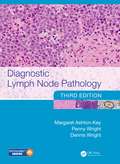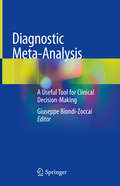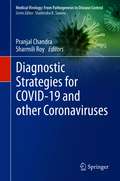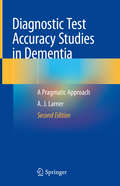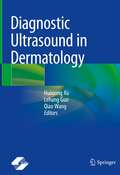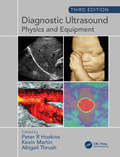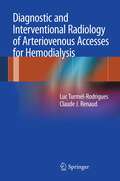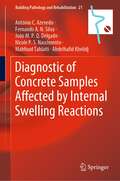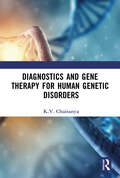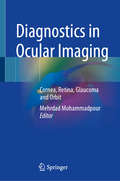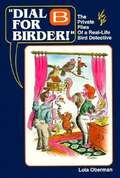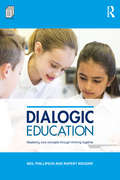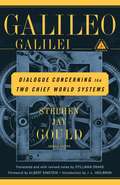- Table View
- List View
Diagnostic Imaging for Veterinary Technicians, 2E
by Margi Sirois Joshua M. SchloteDiagnostic Imaging for Veterinary Technicians is a comprehensive diagnostic imaging textbook, which includes detailed positioning information for radiographic studies in the small animal clinic. The text showcases a systematic approach to the positioning of feline, canine, equine, and exotic animal patients for routine and special radiographic procedures, including dentistry procedures.
Diagnostic Imaging of Novel Coronavirus Pneumonia
by Minming Zhang Bin LinThis book presents radiological findings in patients with 2019 Novel Coronavirus Pneumonia (COVID-19). It starts with a general review of COVID-19 Pneumonia discovery, including etiology characteristics, transmission routes and pathogenic mechanisms. In the following chapters, details in clinical classification, imaging manifestations in different groups, and imaging features of family aggregated coronavirus pneumonia are introduced. In addition, key points in differential diagnosis of COVID-19 Pneumonia are summarized in the last chapter. The book provides a valuable reference source for radiologists and doctors working in the area of COVID-19 Pneumonia.
Diagnostic Liquid-Based Cytology
by Rana S. Hoda Christopher Vandenbussche Syed A. HodaLiquid-based cytology preparations are currently the standard of care for gynecological cytology, and are being increasingly used for non-gynecological cytology. Diagnostic Liquid-Based Cytology serves as a handy guide to diagnostic cytopathology on liquid-based preparations. The authors, renowned experts in the field, provide clear, concise, and practical diagnostic guidance. This handbook equips you to achieve accurate diagnosis of most commonly and uncommonly encountered diseases in exfoliative and aspirated tissue samples from various sites. The key cytopathological features of various diseases are described. The book is lavishly illustrated with dozens of color images that depict the full range of common and rare conditions. Diagnostic Liquid-Based Cytology offers highly practical guidance and information needed to solve common diagnostic challenges in liquid-based cytology preparations. Appropriate histopathological correlations and a consideration of the possible differential diagnosis accompany the cytological findings. The book is an excellent resource not only for practicing pathologists as well as for pathologists-in-training, and will be the perfect practical resource for daily reference in the cytopathology laboratory.
Diagnostic Lymph Node Pathology
by Margaret Ashton-Key Penny Wright Dennis WrightDiagnostic Lymph Node Pathology presents a logical and systematic approach to lymph node biopsies and guides general pathologists and haematopathologists alike through the maze of differential diagnoses, enabling them to reach an accurate diagnosis. The book is presented in an easy-to-read format and contains boxes for quick reference detailing the clinical, morphological, immunohistochemical, and genetic features of each entity. Thoroughly revised, the third edition also includes more than 300 high-quality histological colour photographs along with updated references. This edition covers both classical and less well-known features of individual disease processes. It is a valuable guide for both professionals and trainees.
Diagnostic Meta-Analysis: A Useful Tool for Clinical Decision-Making
by Giuseppe Biondi-ZoccaiThis book is the first exclusively devoted to the systematic synthesis of diagnostic test accuracy studies. It builds upon the major recent developments in reporting standards, search methods, and, in particular, statistical tools specifically devoted to diagnostic studies. In addition, it borrows extensively from the latest advances in systematic reviews and meta-analyses of intervention studies. After a section dedicated to methods for designing reviews, synthesizing evidence and appraising inconsistency in research, the application of these approaches is demonstrated in the context of case studies from various clinical disciplines. Diagnosis is central in medical decision-making, and in many other fields of human endeavor, such as education and psychology. The plurality of sources of evidence on diagnostic test accuracy poses a huge challenge for practitioners and researchers, as do the multiple dimensions of evidence validity, which include sensitivity, specificity, predictive values, and likelihood ratios. This book offers an invaluable resource for anyone aiming to improve decision-making processes in diagnosis, classification or risk prognostication, from epidemiologists to biostatisticians, radiologists, laboratory physicians and graduate students, as any physician interested in refining his methodological skills in clinical diagnosis.
Diagnostic Radiology of the Rheumatic Diseases: Interpreting Musculoskeletal Radiographs, Ultrasound, and MRI
by Anupam Basu Robert S. KatzThis book provides an introduction to the role of medical imaging in the diagnosis and management of rheumatologic diseases. It reviews basic radiographic findings of common and rare arthropathies while offering a focused and practical discussion of advanced imaging modalities such as CT, ultrasonography, and MRI. The book begins with a discussion on soft tissue changes, bone and bone density, articular surface changes, and bone alignment. Following this is an examination of the use of advanced imaging modalities including CT, ultrasound, and MRI as well as different disease categories such as inflammatory arthritis, degenerative arthritis, infectious arthritis, and crystalline arthropathy. Subsequent chapters include exercises and case examples for imaging hands and wrists, knees, hips, foot and ankle, shoulder, and the spine. Diagnostic Radiology of Rheumatic Diseases is an essential and practical resource for senior medical students, residents, fellows, and physicians in rheumatology, imaging and radiology, immunology, and internal medicine.
Diagnostic Samples: From the Patient to the Laboratory
by Walter G. Guder Sheshadri Narayanan Hermann Wisser Bernd ZawtaThis fourth, updated edition contains the latest developments in preanalytical knowledge. An international team of authors summarizes the information on biological influences, analytical interferences and on the variables affecting the collection, transport and storage, as well as preparation of samples. In so doing, they cover age, gender, race, pregnancy, diet, exercise and altitude, plus the effects of stimulants and drugs. National and international standards are described for sampling procedures, transport, sample identification and all safety aspects, while quality assurance procedures are shown for total laboratory management. In addition, this practical book is rounded off by a glossary explaining all terms being used. This book is a must-have for everyone involved in patient care and using or performing laboratory tests.
Diagnostic Strategies for COVID-19 and other Coronaviruses (Medical Virology: From Pathogenesis to Disease Control)
by Pranjal Chandra Sharmili RoyThis book provides fundamental information on various techniques for the detection of SARS-CoV-2 including reverse transcriptase (RT) PCR, loop-mediated isothermal amplification, immunodiagnostic tests, and CRISPR-Cas. It reviews various testing kits and detection methodologies that are currently being used for the detection of SARS-CoV-2 and examines strategies for the post-treatment detection and monitoring of SARS-CoV-2. Further, it assesses the diagnostic potential of several SARS-CoV-2 proteins; and analyzes their structural determinants and immunogenicity.In turn, the book evaluates the potential of CRISPR-Cas 12-based assays for the detection of SARS-CoV-2 using RNA extracted from patients. Lastly, it discusses the use of miniaturized biosensors for the detection of other types of coronavirus.
Diagnostic Test Accuracy Studies in Dementia: A Pragmatic Approach
by A. J. LarnerThe new and updated edition of this book explains the key steps in planning and executing diagnostic test accuracy studies in dementia, serving as an introduction to the topic with clear explanations of difficulties and pitfalls. It has been fully revised in light of developments over the past 5 years and includes STARD publications which have appeared since the first edition as well as the use of biomarkers of cognitive disorders as increasingly enshrined in diagnostic criteria. The book covers the presentation of study results in terms of measures of discrimination, taking examples from studies in dementia looking at various diagnostic methods including cognitive instruments, neuroimaging, and biochemical studies. The book continues to reflect the author’s own experience in diagnostic test accuracy studies, particularly in the sphere of cognitive screening instruments..Diagnostic Test Accuracy Studies in Dementia encourages clinicians to adopt a pragmatic approach to diagnostic test accuracy studies rooted in day-to-day clinical practice.
Diagnostic Ultrasound in Dermatology
by Qiao Wang Huixiong Xu Lehang GuoThis book offers readers details in application of high-frequency ultrasound in dermatology, a new method playing increasingly important roles in diagnosis of skin diseases. At first, chapters introduce anatomy and ultrasound features of normal skin. Then terminology, image quality, and artifact of dermatologic ultrasound are presented. After that, ultrasound features of benign and malignant skin tumors, inflammation, autoimmune disease, and traumas are described with diagnostic tips for specific disease. It will be a valuable reference book not only for dermatologist and radiologist, but also for plastic surgeon and cosmetologist.
Diagnostic Ultrasound, Third Edition: Physics and Equipment
by Peter R Hoskins, Kevin Martin and Abigail ThrushThis popular text provides a comprehensive, yet accessible, introduction to the physics and technology of medical ultrasound, with high quality ultrasound images and diagrams throughout. Covering all aspects of the field at a level that meetings the requirements of accredited sonography courses, it is ideal for both trainee and qualified healthcare professionals practising ultrasound in a clinical setting. Building on the content of previous editions, this third edition provides the latest guidance relating to ultrasound technology, quality assurance and safety and discusses the latest techniques.
Diagnostic Ultrasound: Imaging and Blood Flow Measurements, Second Edition
by K. Kirk ShungOffers an Extensive Discussion on High Frequency UltrasoundBased on a course taught and developed by a foremost expert in diagnostic ultrasound technology, Diagnostic Ultrasound: Imaging and Blood Flow Measurements, Second Edition covers cutting-edge developments, along with the fundamental physics, instrumentation, system architecture, clinical ap
Diagnostic and Interventional Radiology in Gynecological and Obstetric Diseases
by Antonio Pinto Raffaella Niola Francesco GiurazzaThis book focuses on the role of diagnostic and interventional radiology in obstetrical and gynecological diseases. It provides relevant information on each topic, considering both diagnostic and interventional radiology, which now belong to the same professional unit. Each chapter begins with a brief introduction to the most relevant clinical aspects of the pathology. Diagnostic examinations are also discussed, with a focus on the radiological studies (US/CT/MR) functional to subsequent procedures. This is followed by an interventional section, which clarifies the indications, contraindications, techniques (including choice of materials) and follow-up. Lastly, clinical cases are provided, together with multiple-choice review questions. Given its scope, the book will appeal to radiologists, gynecologists and obstetricians, as well as to residents in these specialties.
Diagnostic and Interventional Radiology of Arteriovenous Accesses for Hemodialysis
by Claude J. Renaud Luc Turmel-RodriguesThis is the first textbook entirely dedicated to the endovascular treatment of complications related to arteriovenous accesses for hemodialysis (native fistulas and prosthetic grafts). The book addresses the anatomy of upper limb arteries and veins as well as the clinical presentation of patients and the way to perform and read a fistulogram. Many details and illustrations are provided, clarifying the subtleties in catheterization and the dilation of stenoses. From a strategic point of view, it is explained for the first time that many stenoses must either be ignored or deliberately underdilated. A wealth of images helps to understand the different stages of access recovery from thrombosis. As the number of incident dialysis patients is increasing by 5% every year, this is a field of growing interest. In testament to this there are several annual or bi-annual meetings held by numerous national and international societies (vascularaccesssociety.com, sfav.org, vasamd.org, dialysiscontroversies.org, asdin.org).
Diagnostic of Concrete Samples Affected by Internal Swelling Reactions (Building Pathology and Rehabilitation #21)
by António C. Azevedo Fernando A.N. Silva João M.P.Q. Delgado Nicole P.S. Souza Mahfoud Tahlaiti Abdelhafid KhelidjThis book offers a complete diagnosis of concrete samples collected from a pile cap block of residential buildings affected by internal swelling reactions. Covering an extensive laboratory campaign to evaluate the transport properties of concrete samples, as well as their physical and chemical composition using advanced techniques to analyse cores extracted from real buildings that have concrete elements affected by internal swelling reactions (ISR). It features several rehabilitation procedures, pile caps repair and rehabilitation design, executed using strengthening procedures to provide the complete restoration of the structural integrity of the element deteriorated. These rehabilitation procedures proved to be a good solution to retrofit pile cap deteriorated by expansions due to internal swelling reactions of concrete. The book also offers a systematic review of the current state of knowledge and it is a valuable resource for scientists, students, and practitioners in various scientific and engineering disciplines, namely, civil and materials engineering, as well as and other interested parties.
Diagnostics and Gene Therapy for Human Genetic Disorders
by K.V. ChaitanyaDiagnostics and Gene Therapy for Human Genetic Disorders provides an integrative and comprehensive source of information blending classical human genetics with the human genome. It provides a multidisciplinary overview of Mendelian inheritance and multifactorial inheritance, genetic variations, polymorphisms, chromosomal, multifactorial, and mitochondrial disorders. PCR, electrophoresis, cytogenetics, prenatal, and HPLC based techniques applied for diagnosing genetic disorders are discussed with applications. Symptoms, etiology, diagnosis, treatment of 14 major and 5 minor genetic disorders are discussed in detail. Methods employed for the preparation of kits for the diagnosis of diseases are provided. The role of gene therapy in the amelioration of genetic disorders and the methodology employed are discussed. The success of gene therapy in controlling various disorders such as immune system disorders, neurodegenerative disorders, cardiovascular disorders, eye diseases, and cancer has been described along with type studies. Features: A blend of classical human genetics with molecular and genome-based applications Techniques applied for the diagnosis of genetic disorders Diagnostics of 19 genetic disorders including symptoms, etiology, diagnosis, and treatment Role of gene therapy in the amelioration of disorders Type studies describing the role of diagnostics in conserving the human health This book attempts to connect all the information about classical and modern human genetics, genetic disorders, and gene therapy to all types of diseases in one place. This work provides a comprehensive source of information that can serve as a reference book for scientific investigations and as a textbook for the graduate students.
Diagnostics in Ocular Imaging: Cornea, Retina, Glaucoma and Orbit
by Mehrdad MohammadpourThis book presents a new avenue in the field of ophthalmology and sheds light on the field of eye imaging. With the increasing availability of electronic devices and their important role in both personal and professional aspects of human life, there is a growing need for perfect vision. Ophthalmic imaging is a major tool for screening and documenting eye diseases in both medical and surgical fields of ophthalmology and is also of use for ophthalmologists around the globe. The number of eye-imaging devices has increased dramatically, however undiagnosed or poorly managed eye diseases remain a significant cause of ocular and visual problems worldwide. This essential guide addresses the need for a book that is dedicated to ophthalmic imaging, covering the cornea, glaucoma, retina and orbital imaging with updates on medical and surgical aspects of the topic.
Diagnostics in Plant Breeding
by Rajeev Varshney Thomas Lübberstedt"Diagnostics in Plant Breeding" is systematically organizing cutting-edge research reviews on the development and application of molecular tools for the prediction of plant performance. Given its significance for mankind and the available research resources, medical sciences are leading the area of molecular diagnostics, where DNA-based risk assessments for various diseases and biomarkers to determine their onset become increasingly available. So far, most research in plant genomics has been directed towards understanding the molecular basis of biological processes or phenotypic traits. From a plant breeding perspective, however, the main interest is in predicting optimal genotypes based on molecular information for more time- and cost-efficient breeding schemes. It is anticipated that progress in plant genomics and in particular sequence technology made recently will shift the focus from "explanatory" to "predictive" in crop science. This book assembles chapters on all areas relevant to development and application of predictive molecular tools in plant breeding by leading authorties in the respective areas.
Diagrammatica
by Martinus VeltmanThis author provides an easily accessible introduction to quantum field theory via Feynman rules and calculations in particle physics. His aim is to make clear what the physical foundations of present-day field theory are, to clarify the physical content of Feynman rules. The book begins with a brief review of some aspects of Einstein's theory of relativity that are of particular importance for field theory, before going on to consider the relativistic quantum mechanics of free particles, interacting fields, and particles with spin. The techniques learnt in the chapters are then demonstrated in examples that might be encountered in real accelerator physics. Further chapters contain discussions of renormalization, massive and massless vector fields and unitarity. A final chapter presents concluding arguments concerning quantum electrodynamics. The book includes valuable appendices that review some essential mathematics, including complex spaces, matrices, the CBH equation, traces and dimensional regularization. An appendix containing a comprehensive summary of the rules and conventions used is followed by an appendix specifying the full Lagrangian of the Standard Model and the corresponding Feynman rules. To make the book useful for a wide audience a final appendix provides a discussion of the metric used, and an easy-to-use dictionary connecting equations written with different metrics. Written as a textbook, many diagrams, exercises and examples are included. This book will be used by beginning graduate students taking courses in particle physics or quantum field theory, as well as by researchers as a source and reference book on Feynman diagrams and rules.
Dial B for Birder: Private Files of a Real Life Bird Detective
by Lola Oberman[From the back cover:] "When Lola Oberman's telephone rings, expect a mystery. What was that "huge, six-foot bird" that a worried motorist spotted standing by the roadside? Who or what is murdering hapless wood ducks on the Mississippi Flyway? And what kind of bird was the brash creature that interrupted the President's speech at the White House with its loud, melodious outbursts? Dial B for Birder is a collection of such mysteries. As a telephone bird identifier for the Audubon Naturalist Society, author Lola Oberman has become the Jessica Fletcher of birders--an authority who can "name that bird in five minutes." If you've ever been baffled by a colorful bird in your back yard, you'll be fascinated as the author wrestles clues from her callers and goes on to solve birding mysteries large and small. In 1976, Lola Oberman left the world of national politics (she was a speechwriter and political aide) for the world of birds. She is contributing editor to Bird Watcher's Digest, and her popular birdwatching column, "Notes from Melody Lane," appears in Audubon Naturalist News. Her first book, The Pleasures of Watching Birds, has been endorsed by the father of modern birding, Roger Tory Peterson. Dial B for Birder is a book like no other. For lovers of birds--or lovers of mysteries--it will become a thumb-worn classic and a permanent fixture on the old-favorites bookshelf." For anyone lacking the visual acuity to see birds, this book provides descriptions of the appearance and behavior of well known and lesser known birds that are so vivid the reader will feel convinced they have had the pleasurable experience of actually seeing the marvelous sight of birds from house sparrows to baby hummingbirds, from gulls to wood ducks, from crows to grackles and from snowy owls to red tailed hawks, and many, many more.
Dialogic Collaborative Action Research in Science Education: Collaborative Conversations for Improving Science Teaching and Learning (ISSN)
by Allan Feldman Jawaher Alsultan Katie Laux Molly NationThis engaging and practical book offers science teacher educators and K-12 science teachers alike the tools to engage in a dialogic mode of collaborative action research (D-CAR), a collaborative mode of action research focused on teachers’ experiences with students, reflection upon these experiences, and peer learning.Renowned science educator Allan Feldman and co-authors from across numerous settings in K-12 science education present the theory, methodology, case studies, and practical advice to support the use of D-CAR as a means to enhance teachers’ normal practice and address the problems, dilemmas, and dissonances that science teachers must negotiate as they work to meet the needs of an increasingly diverse student population and engage with complex science teaching challenges that disproportionately affect marginalized students.The book will be of use to science teacher educators, pre-service and in-service science teachers, professional development specialists, or any science educator invested in developing creative, reflective, and thoughtful teachers.
Dialogic Collaborative Action Research in Science Education: Collaborative Conversations for Improving Science Teaching and Learning (Teaching and Learning in Science Series)
by Allan Feldman Jawaher Alsultan Katie Laux Molly NationThis engaging and practical book offers science teacher educators and K-12 science teachers alike the tools to engage in a dialogic mode of collaborative action research (D-CAR), a collaborative mode of action research focused on teachers’ experiences with students, reflection upon these experiences, and peer learning. Renowned science educator Allan Feldman and co-authors from across numerous settings in K-12 science education present the theory, methodology, case studies, and practical advice to support the use of D-CAR as a means to enhance teachers’ normal practice and address the problems, dilemmas, and dissonances that science teachers must negotiate as they work to meet the needs of an increasingly diverse student population and engage with complex science teaching challenges that disproportionately affect marginalized students. The book will be of use to science teacher educators, pre-service and in-service science teachers, professional development specialists, or any science educator invested in developing creative, reflective, and thoughtful teachers.
Dialogic Education: Mastering core concepts through thinking together (Computer-Supported Collaborative Learning Series #7)
by Rupert Wegerif Neil PhillipsonDialogue has long been used in primary classrooms to stimulate thinking, but it is not always easy to unite the creative thinking of good dialogue with the need for children to understand the core concepts behind knowledge-rich subjects. A sound understanding of key concepts is essential to progress through the national curriculum, and assessment of this understanding along with effective feedback is central to good practice. Dialogic Education builds upon decades of practical classroom research to offer a method of teaching that applies the power of dialogue to achieving conceptual mastery. Easy-to-follow template lesson plans and activity ideas are provided, each of which has been tried and tested in classrooms and is known to succeed. Providing a structure for engaging children and creating an environment in which dialogue can flourish, this book is separated into three parts: Establishing a classroom culture of learning; Core concepts across the curriculum; Wider dialogues: Educational adventures in the conversation of mankind. Written to support all those in the field of primary education, this book will be an essential resource for student, trainee and qualified primary teachers interested in the educational importance of dialogue.
Dialogue Concerning the Two Chief World Systems: Ptolemaic and Copernican
by Stephen Jay Gould Stillman Drake GalileoGalileo's Dialogue Concerning the Two Chief World Systems, published in Florence in 1632, was the most proximate cause of his being brought to trial before the Inquisition. Using the dialogue form, a genre common in classical philosophical works, Galileo masterfully demonstrates the truth of the Copernican system over the Ptolemaic one, proving, for the first time, that the earth revolves around the sun. Its influence is incalculable. The Dialogue is not only one of the most important scientific treatises ever written, but a work of supreme clarity and accessibility, remaining as readable now as when it was first published. This edition uses the definitive text established by the University of California Press, in Stillman Drake's translation, and includes a Foreword by Albert Einstein and a new Introduction by J. L. Heilbron.
Dialogue and Dementia: Cognitive and Communicative Resources for Engagement
by Martin J. Ball Nicole Müller Robert W. Schrauf Jack S. DamicoThis volume takes the positive view that conversation between persons with dementia and their interlocutors is a privileged site for ongoing cognitive engagement. The book aims to identify and describe specific linguistic devices or strategies at the level of turn-by-turn talk that promote and extend conversation, and to explore real-world engagements that reflect these strategies. Final reflections tie these linguistic strategies and practices to wider issues of the "self" and "agency" in persons with dementia. Thematically, the volume fosters an integrated perspective on communication and cognition in terms of which communicative resources are recognized as cognitive resources, and communicative interaction is treated as reflecting cognitive engagement. This reflects perspectives in cognitive anthropology and cognitive science that regard human cognitive activity as distributed and culturally rooted. This volume is intended for academic researchers and advanced students in applied linguistics, linguistic and medical anthropology, nursing, and social gerontology; and practice professionals in speech-language pathology and geropsychology.



